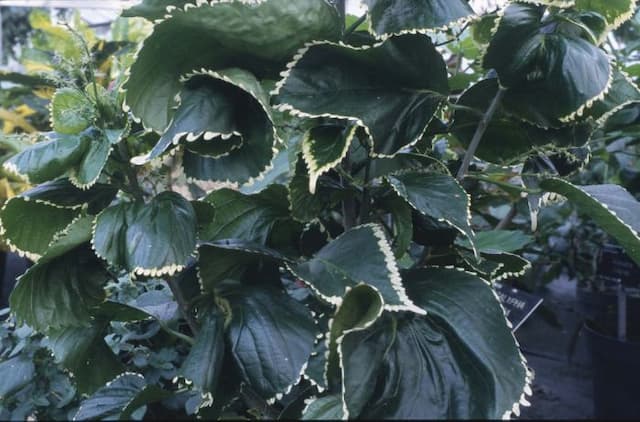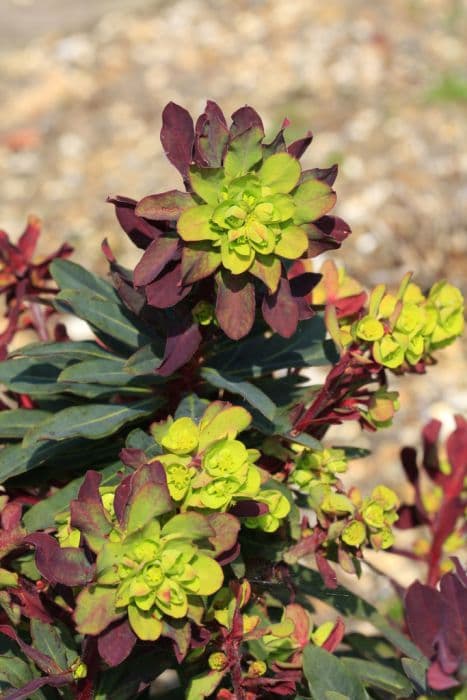Cushion Spurge Euphorbia epithymoides 'Senior'

ABOUT
Euphorbia epithymoides 'Senior', commonly known as cushion spurge, has a distinctive appearance that brightens up any garden space. This perennial plant is known for its bushy, mounded clumps of foliage that change hues with the seasons. In spring, the leaves emerge a light green, producing a vibrant backdrop for the plant's most striking feature—its flowers. While the actual flowers are tiny and inconspicuous, they are surrounded by showy, bright yellow bracts that resemble petals, and these bracts appear in clusters that create a dome-shaped display above the foliage. As the seasons progress into summer, the foliage of cushion spurge transitions to a darker green, offering a rich tapestry of color and texture. The yellow bracts may linger for some time before fading. In autumn, the leaves take on a dramatic change, developing shades of red, orange, or purple, adding a warm and inviting splash of color to the fall garden. Cushion spurge has a rounded habit with the leaves densely packed on the stems. The leaves themselves are small and oval-shaped, with a slightly waxy surface that can make the foliage glisten in the sunlight. These leaves are arranged in a spiraling pattern around the stems, which adds to the visual interest of this plant. The overall impression of Euphorbia epithymoides 'Senior' is one of bright, cheerful color and a well-structured form that provides visual interest throughout multiple seasons. Its eye-catching bracts in spring and colorful foliage in fall make it a popular choice for gardeners looking to create a varied landscape with year-round appeal.
About this plant
 Names
NamesFamily
Euphorbiaceae
Synonyms
Cushion Spurge, Polychrome Spurge
Common names
Euphorbia polychroma 'Senior'
 Toxicity
ToxicityTo humans
Spurge is known for its toxic milky sap, which all parts of the plant contain. The sap can cause irritation of the skin and eyes on contact; if ingested, it can lead to symptoms such as burning pain in the mouth and throat, nausea, vomiting, and diarrhea. In some cases, more severe reactions might occur, especially in individuals with latex allergies, as the sap contains compounds similar to those found in latex.
To pets
Spurge can be toxic to pets if ingested, as it contains a milky sap that is irritating to the gastrointestinal tract. This can lead to symptoms such as vomiting, diarrhea, drooling, and sometimes more severe symptoms like shaking or tremors in pets. It is important to prevent pets from chewing on or ingesting this plant.
 Characteristics
CharacteristicsLife cycle
Perennials
Foliage type
Deciduous
Color of leaves
Green
Flower color
Yellow
Height
1-2 feet (30-60 cm)
Spread
1-2 feet (30-60 cm)
Plant type
Herb
Hardiness zones
5
Native area
Europe
Benefits
 General Benefits
General Benefits- Low Maintenance: Euphorbia epithymoides 'Senior' is known for being easy to care for, requiring minimal upkeep once established.
- Drought Tolerant: This plant is highly resistant to drought, making it ideal for water-conservative gardens or arid climates.
- Attracts Pollinators: The flowers of the Cushion Spurge attract bees and butterflies, beneficial for pollinating nearby plants.
- Deer Resistant: The somewhat toxic sap of Cushion Spurge makes it deer resistant, an advantage in areas with high deer populations.
- Seasonal Interest: With its bright yellow-green flowers in spring and red, purple or orange foliage in the fall, it adds color to gardens across multiple seasons.
- Soil Versatility: It adapts to a range of soil types, although it prefers well-draining soils, making it suitable for various garden situations.
- Good Ground Cover: Cushion Spurge can spread to form a dense mat, which helps suppress weeds and cover bare spots in the garden.
- Landscape Design: Its unique shape and vibrant color make it an excellent choice for borders, rock gardens, and mixed perennial beds.
- Fast Growing: The plant grows relatively fast, filling in garden spaces quickly and providing rapid results for landscape projects.
 Medical Properties
Medical PropertiesThis plant is not used for medical purposes.
 Air-purifying Qualities
Air-purifying QualitiesThis plant is not specifically known for air purifying qualities.
 Other Uses
Other Uses- Cushion Spurge can be used as a natural barrier or border in landscaping due to its dense growth habit.
- The milky sap of Cushion Spurge contains latex, which can be used as a natural adhesive in some traditional craft applications.
- Cushion Spurge can be planted as part of a green roof or living roof system for its low-maintenance growth and drought resistance.
- The plant can be used in dried flower arrangements, with its interesting seed pods adding texture and visual interest.
- Due to its distinct foliage color, Cushion Spurge can be used as a dye plant for coloring fabrics or yarns.
- As a companion plant in the garden, Cushion Spurge can help to deter certain types of pests with its toxic sap.
- Cushion Spurge can be used in xeriscaping, which is a landscaping method that reduces or eliminates the need for supplemental water from irrigation.
- The plant's ability to tolerate poor soil makes it suitable for erosion control on slopes and banks.
- In garden design, Cushion Spurge's vibrant foliage can be used to create a striking contrast with other plants.
- The plant's unique appearance can be utilized in fantasy-themed gardens, adding an otherworldly touch to the landscape.
Interesting Facts
 Feng Shui
Feng ShuiThe Cushion Spurge is not used in Feng Shui practice.
 Zodiac Sign Compitability
Zodiac Sign CompitabilityThe Cushion Spurge is not used in astrology practice.
 Plant Symbolism
Plant Symbolism- Resilience: Euphorbia epithymoides, commonly known as Cushion Spurge, often symbolizes resilience due to its ability to thrive in challenging conditions and its robust nature.
- Protection: The plant's milky sap is known for being a skin irritant, hence Cushion Spurge can represent protection, symbolizing a natural guard against harm and adversity.
- Abundance: Cushion Spurge produces a profusion of yellow-green flowers in spring, making it a symbol of abundance and prosperity.
- Persistence: Due to its long flowering season and its vigorous growth habit, Cushion Spurge is often associated with persistence and enduring effort.
 Water
WaterThe plant commonly known as cushion spurge should be watered regularly, but with care to avoid waterlogging as it prefers well-drained soil. During the growing season in spring and summer, aim to provide about one inch of water per week, either through rainfall or supplemental watering. Adjust the frequency to ensure the soil is moist but not soggy, allowing the topsoil to dry out slightly between watering sessions. In the winter, reduce watering significantly as the plant goes dormant and requires less moisture. It is best to water early in the morning to allow any excess to evaporate during the day.
 Light
LightCushion spurge thrives in full sun but can tolerate partial shade. The ideal spot for this plant is in an area where it can receive at least six hours of direct sunlight daily. If the plant is placed indoors or in a garden with limited sunlight, ensure that it has exposure to the brightest light possible during the daylight hours.
 Temperature
TemperatureCushion spurge prefers temperate conditions and is cold-hardy, typically surviving in temperatures as low as -30°F, making it suitable for USDA hardiness zones 4 to 8. The plant can tolerate high temperatures as long as it is not exposed to extreme heat for prolonged periods. The ideal temperature range for cushion spurge to flourish is between 60°F and 75°F.
 Pruning
PruningCushion spurge benefits from pruning to maintain its shape, encourage bushier growth, and remove spent flowers to potentially prolong the blooming period. It's best to prune in late winter or early spring before new growth begins. Cut back any dead or diseased stems as well as any that may be out of shape. Additionally, after the plant has finished flowering, trim back the flower stems to tidy up the plant and stimulate new foliage growth.
 Cleaning
CleaningAs needed
 Soil
SoilCushion spurge (Euphorbia epithymoides 'Senior') thrives in well-draining soil with a mix of loam, sand, and organic matter like compost. The ideal soil pH for cushion spurge is between 6.0 and 7.0. A specific recipe could be 2 parts loam, 1 part sand, and 1 part compost or aged manure to ensure nutrients and proper drainage.
 Repotting
RepottingCushion spurge typically does not require frequent repotting as it is largely grown as a garden perennial. Repotting can be done every 2-3 years or when it outgrows its current pot or space. However, in garden settings, division may occur every few years to manage growth rather than repotting.
 Humidity & Misting
Humidity & MistingCushion spurge prefers average humidity conditions and is quite adaptable, not requiring any special humidity modifications. It is well-suited to outdoor humidity levels and does not need the high humidity some houseplants require.
 Suitable locations
Suitable locationsIndoor
Place in bright, indirect light; water sparingly.
Outdoor
Full sun to part shade, well-drained soil, mulch yearly.
Hardiness zone
4-8 USDA
 Life cycle
Life cycleEuphorbia epithymoides 'Senior', commonly known as Cushion Spurge, begins its life cycle as a seed, which, upon finding suitable conditions in terms of soil and temperature, germinates in the spring. The seedling then develops into a compact perennial plant with a dense, rounded form, growing up to 18 inches tall and wide. Throughout the spring and into early summer, it produces bright yellow-green, cup-shaped flowers that create a vibrant display. After flowering, the plant goes into a period of vegetative growth, where it builds up its reserves and prepares for the next flowering season. In the fall, the foliage may take on a reddish or purple hue, contributing to the garden's autumnal color palette. With the onset of winter, the plant becomes dormant, retreating to the root system until the favorable growth conditions of spring return.
 Propogation
PropogationPropogation time
Spring to early summer
Propogation: The Euphorbia epithymoides 'Senior', commonly known as cushion spurge, is commonly propagated by division, which is best done in the early spring or fall. To propagate by division, dig up an established clump of cushion spurge and carefully separate the root ball into smaller sections, ensuring that each new piece has a portion of the root system attached. These divisions can then be replanted into well-draining soil, spaced approximately 12 inches (30 centimeters) apart to allow room for growth. Water the newly planted divisions regularly to help them establish. This method is popular because it maintains the characteristics of the parent plant and allows gardeners to quickly expand their cushion spurge plantings.



![Spurge [Blackbird]](/_next/image?url=https%3A%2F%2Fplants-admin.emdemapps.com%2Fimages%2Fplants%2F%2Fimages%2F604b535f37783.png&w=640&q=75)





